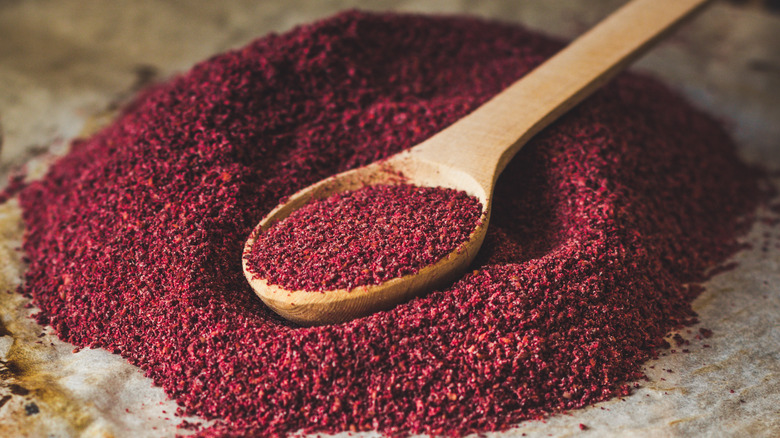The Underrated Spice Padma Lakshmi Uses All The Time
Padma Lakshmi is an expert on the wide world of spices. Not only is she a longtime host and judge on "Top Chef," but Lakshmi also wrote the book on spices ... literally. You'll find the A-to-Z's of spices in her reference book "Spices & Herbs: An Essential Guide to the Flavors of the World" (via HarperCollins). Lakshmi has more than book smarts when it comes to spices, too. She puts her spice-pertise into practice during her long hotel stays when filming "Top Chef."
"I have a little toolkit of spices," Lakshmi told Food & Wine, "like black mustard seeds, some spice blends, sumac, and za'atar, Aleppo chili, and Urfa." Hold on, back up a minute. Did she say "sumac?" As in, poison sumac, the rash-inducing plant that's often confused with poison ivy and poison oak but is in fact different from both (via Healthline)? The American Indian Health and Diet Project says the white berries from poison sumac are poisonous, too, so hopefully Lakshmi isn't grinding those up for her spice collection.
Of course she knows better than that. So did Native Americans, and cooks from Palestine to Persia (via NPR). The sumac with red berries is not only safe to eat, but it's a unique and underrated spice that brings a tart, citrusy flavor that's not as sharp as lemon, according to Lakshmi's essay about sumac on Substack.
Padma Lakshmi discovered sumac in her Persian friend's kitchen
As a native of south India, Padma Lakshmi has a close relationship with the spice tamarind, as she revealed when she opened her refrigerator door for food podcaster Dan Ahdoot in an episode of "Green Eggs and Dan." She had three or four different kinds of tamarind at least in her fridge: a concentrate, pressed tamarind, tamarind chutney. "I love sour, I love tart, I love acid," Lakshmi said. Her early-childhood experiences with tamarind may have primed her tastebuds for the tartness of sumac — a spice Lakshmi didn't discover until college, visiting the Persian home kitchen of one of her friends. She relates the story in her Substack essay.
Lakshmi first glimpsed the mysterious "vermillion-colored powder" while watching her friend's mother cook. Sprinkled over yogurt dip, it looked like crushed garnets. "What is that spice you're using? It's beautiful!" Lakshmi remembers asking this Persian mom. Then Lakshmi learned its name was sumac, and right after that she learned its flavor: tart, fruity, and mouth-watering.
Sumac is a widely used, versatile spice in places such as Turkey, Lebanon, Iran, and Iraq. It's added to grilled fish, chicken, and other meats. Sumac is mixed with yogurt to make a marinade, or sprinkled over rice, baba ghanoush or hummus with olive oil to add color and flavor. For Lakshmi and sumac, it was love at first taste. "I use it all the time," she said.

